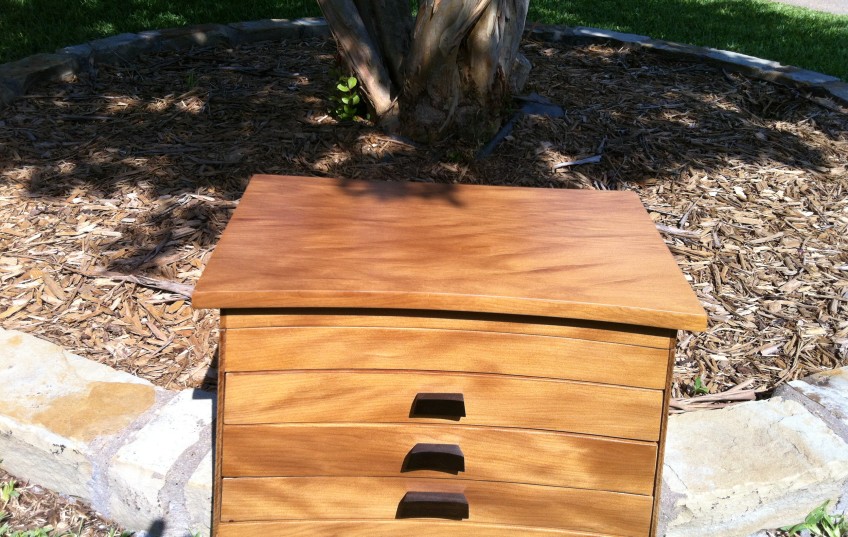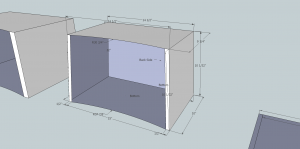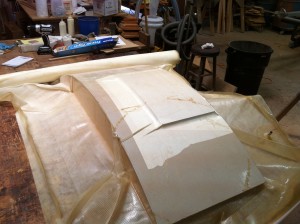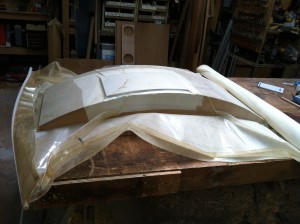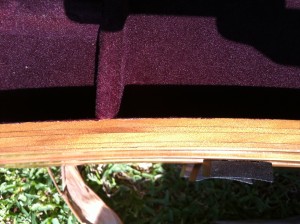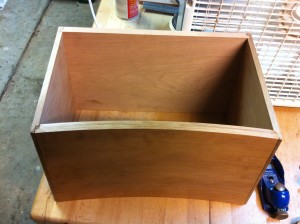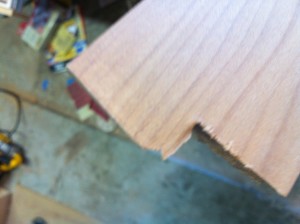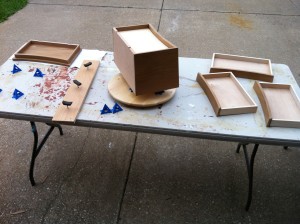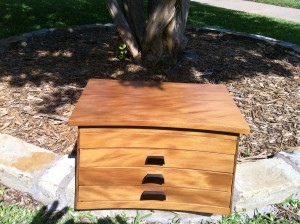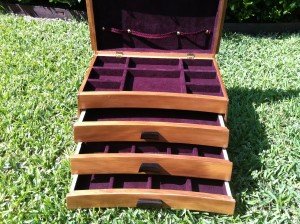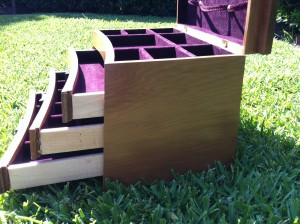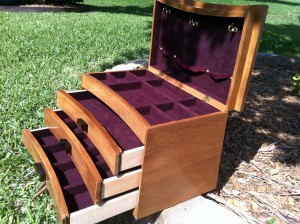I have FINALLY completed this project, which was the source of much ‘analysis paralysis’ for me. The client approached me months ago, wanting to surprise his wife with a custom-made jewelry box. He gave three pieces of guidance:
1) A budget
2) A desire for a clean, contemporary piece and
3) A suggestion that I really challenge myself technically
This might seem silly, but I’ve never seen a jewelry box before. I normally make big, custom furniture, not little boxes. And my personal jewelry consists of a wedding ring that I never take off and an heirloom watch that I never wear. My wife, bless her, isn’t a big wearer of bling either. So on many fronts, this was a bold step that I made over the course of, ummm, 5 months. Kind of like getting into the cold swimming pool one toe at a time.
To start with, I want to talk about what the jewelry box is made out of. I used 2 of the woods that are generally considered to be among the most expensive in the world: Ancient Kauri and Gabon (Gabbon/Gabboon) Ebony. The majority of the box is comprised of Ancient Kauri, and it is REALLY extraordinary stuff. The wood comes from huge trees in New Zealand that fell and were buried in a peat bog at least 52,000 years ago. I say 52,000 years because the lab in Louisiana that carbon dated the particular wood in this box said that the carbon dating process is only accurate to 52,000 years. So all we know is this wood is OLDER than that. The peat bog provided an anoxic environment, so the wood was perfectly preserved. It didn’t fossilize or rot; it just lay there, waiting to be dug up by some industrious New Zealanders.
If any of this sounds familiar, there was an episode on the History Channel about it (Modern Marvels: episode ‘The Lumberyard’). Hopefully, this link will stay active for a while. The whole show is a fascinating explanation of my chosen medium, but the segment on kauri is at the 40:45 mark:
[youtube]http://www.youtube.com/watch?v=hb0wA–VSnU[/youtube]For the ecologically conscious among us, Ancient Kauri is LEED certified as a reclaimed wood. Similarly, the ebony pulls were harvested from the only sustainable ebony operation in the world (in West Africa).
Design: I designed this project from scratch. My goal was contemporary, clean, maybe a little Japanese. The lines on it are subtle, but I assure you that almost nothing on this project is square. The sides cant in at 5 degrees. The curved drawer fronts cant back at 5 degrees. The top is beveled in at 5 degrees. My goal was to create a subtle thin-ness causing the eye to travel up from bottom to top. I spent approximately 30 hours on the design.
The design started with a curved box front. I then added the subtle tapers on the front and the sides. I then spent way to long figuring out the right way to build what I’d designed.
Construction: Because almost nothing is square, this proved to be the most complicated construction I’ve ever made. The front of the box is curved. I did this using a technique called ‘bent lamination.’ I took two, 1” thick pieces of ancient kauri. Then I used my bandsaw and resawed the pieces into roughly 1/8 inch thick, 12 inch wide strips. I kept the pieces in order, put glue between each piece, placed that stack of laminations on a form created for that purpose, put all that crap in a huge vaccum bag, and used a vaccum press to ‘pull’ the laminations to the form. After the glue cured, we had a large, bent piece of wood. I then cut strips off of that to make the drawer fronts.
Here’s the box front in the vacuum press:
Here’s what the bent laminations look like after they were finished:
The back of the box is Black Cherry from Pennsylvania.
The drawers were the toughest part of this project. The drawer sides are made of Tiger Maple and were cut at compound angles, angling in 5 degrees and back 5 degrees. Then I had to get that joined to a curved drawer front. The 3 drawers took about 50 hours to make, with one ‘oh @#$%, starting over’ thrown in. The rest of the project took about 70 labor hours, so you get a sense about the challenge of the drawers.
I finished the box with 2 coats of shellac and 5 coats of General Finishes high gloss Polyacryllic.
I ‘flocked’ the thing with Aggie maroon. Flocking is a process where you basically paint the surface with maroon paint, then take a hand pump and pump little velvet fibers all over the paint. It cures and you’ve been velvetized.
At some point, this thing got totally out of hand and just became a labor of love. I talked with my mentor and a couple other professional woodworkers, and there was general agreement that making a little box like this is at least as time consuming as making a big box such as a chest of drawers, because all the joinery is still there, only in miniature.
For those of you who are intrigued by this ancient kauri, I’m pleased to announce that LoneStar Artisans will have 2 new artisans joining our team soon. They will be turning extremely high end writing pens made from ancient kauri, Texas mesquite, and a figured wood to be named later. Supply of the kauri pens will be limited (and they will be expensive). Stay tuned!
Finally, here’s a little Youtube video I created on my iphone. Sorry about the quality:
[youtube]http://www.youtube.com/watch?v=9eNW-XTJeTQ&feature=youtu.be[/youtube]

